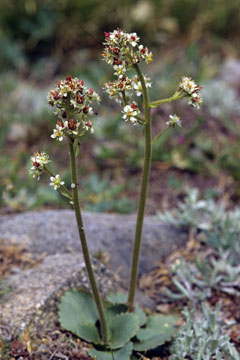 |
Mountain saxifrage, Saxifraga
occidentalis S. Watson
(left, right) blooms in early summer. preferring the moist ground of mountain
meadows and the banks of mountain lakes. Its stem that gives off many stemlets
each bearing a cluster of white flowers. Each flower has two prominent red
carpals that mature into a two-parted capsule (“follicle”)
|
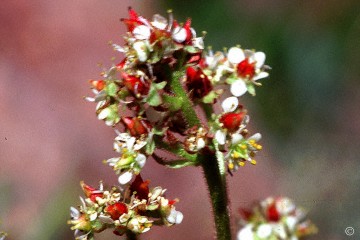 |
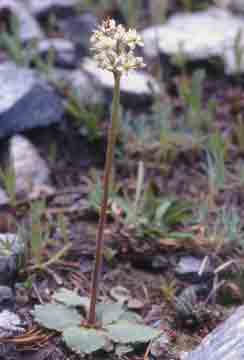 |
Diamond leaf saxifrage, Saxifraga
rhomboidea Greene (left,
right) is quite similar to the mountain saxifrage shown above, differing
in the shape of its leaves (reflected in rhomboidea) and
having light colored fruiting bodies. It is not uncommonly
seen in the mountains of Central Idaho. Several other saxifrages, similar
to this and to the mountain saxifrage, also occur in our mountains. |
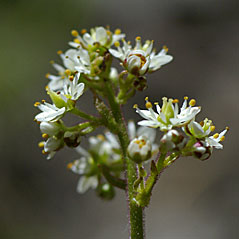 |
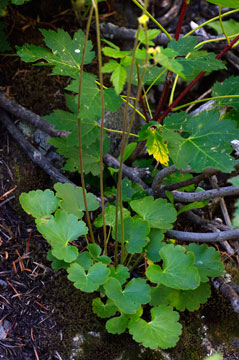 |
Wood, or woodland saxifrage, Saxifraga
mertensiana Bong. (left,
right) grows in shaded, moist situations commonly on or near streambanks.
It is found at all elevations, as high as treeline.The plants are tall with
long stems bearing small flowers. The round, scalloped leaves as well as
its growth situation help with identification. It is native to the Pacific
coastal states from Alaska to California and east to Alberta, Idaho and
Wyoming. |
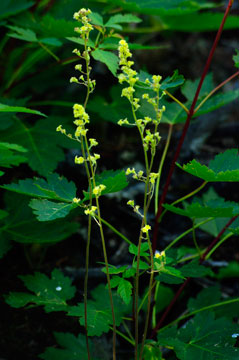 |
 |
Purple saxifrage, Saxifraga
oppositifolia L. (left,
right), The purple saxifrage forms dense cushions on the rocky ground of
alpine tundra. The flowers, borne on almost non-existent stems, bloom while
there is snow on nearby slopes. Its tiny, opposite leaves are tightly arrayed.
Striking pink to purple, five-petaled flowers range up to an inch in diameter.
This is a circumboreal arctic/alpine plant found not only in our mountains,
but throughout the northern part of the northern hemisphere and in the alpine
ranges of the Old World. |
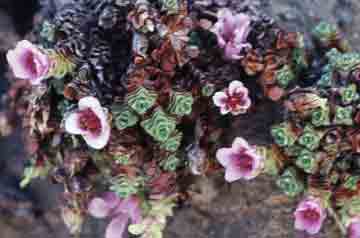 |
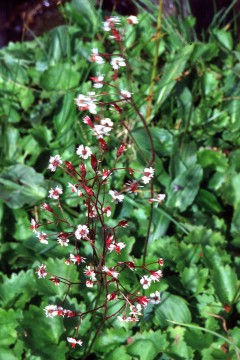 |
Brook saxifrage, Saxifraga
odontoloma Piper (left),
, formerly Saxifraga arguta, is typical of plants in the genus Saxifraga
in having a basal cluster of leaves and a long stem bearing many small flowers.
The brook saxifrage is common in our mountains, often turning streambanks
green with its leaves. Identify the plants by their attractive, bright green,
deeply scalloped, oval or fan-shaped leaves. These give the plant both its
old and new species name (both mean “toothed”). The brook saxifrage
is able to thrive in varying light intensities, growing equally well in bright
sunlight or deep shade.
Poker alumroot, Heuchera
cylindrica Douglas ex
Hook. (right) is quite similar in appearance and in growth
habit to the gooseberry-leaved alumroot shown below, differing mainly in
the shape of its leaves. There is considerable difference in this plant’s
morphology from place to place and even from plant to plant, and six different
varieties are recognized that have minor variations in leaf shape. Unlike
Heuchera grossularifolia, the petals are sometimes absent in the flowers
of this species. |
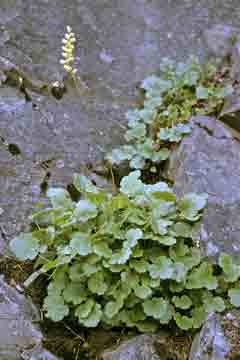 |
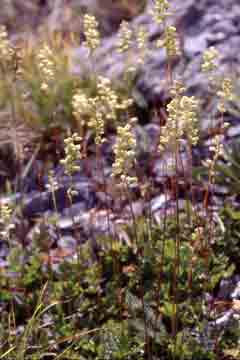 |
Gooseberry-leaved alumroot, Heuchera
grossulariifolia
Rydb. (left, right) blooms from late spring well into
the summer, favoring cliffsides (where it usually grows as a solitary plant)
and rocky ground where it may grow in clusters, from mid-elevations to alpine
tundra. The species name is derived from the resemblance of its leaves to
those of gooseberries. Its small flowers have five sepals joined to form
a bell-shaped receptacle that almost hides the petals. The popular name,
alumroot, is derived from its puckery taste, for the roots and stems contain
a high concentration of tannin. The generic name honors Johann Heinrich von
Heucher (1677-1747), Professor of Medicine at Wittenberg in Germany. |
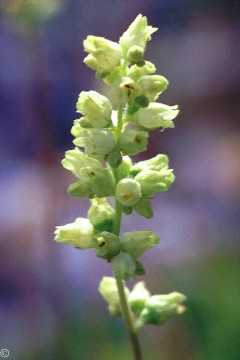 |
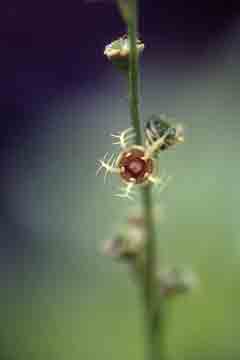 |
Five-stamen mitrewort, Mitella
pentandra Hook. (left) and
Side-flowered mitrewort, Mitella stauropetala Piper (right)
are two of the four species of Mitella that grow in Idaho. Mitellas
prefer moist environments and are usually found in shaded woods and along
stream banks. As with many other plants in the saxifrage family, the
plants’ basal leaves are disproportionately large when compared to the
tiny flowers (greatly magnified in these illustrations) that occupy the end
of long stems. The bizarre little flowers with five skeletal petals will
be easily recognized when first seen. The word mitella is a diminutive
form of the Latin mitra (“hat” or “cap”), a reflection
of the shape of the plants’ fruiting body ,said to resemble a bishop’s
hat. The name pentandra mirrors the common name "five-stamen,"and
stauropetala, from the Greek ,means "cross-petal" for the shape of
its attenuated petals. |
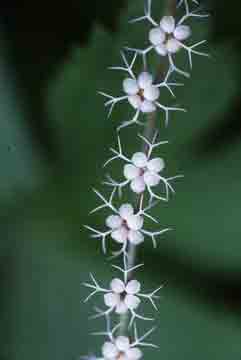 |
 |
Smallflower woodlandstar, Lithophragma
parviflorum (Hook.)
Nutt. ex Torr. & A. Gray (left). The woodlandstars
(also “prairiestars”) are eye-catchers, thanks to their cleft white
petals. Prominent calyces with five pointed tips cup the flowers. The petals
have, depending on the species, three, five, or seven lobes. Small flower
clusters are borne atop long, reddish to purple colored stems that arise
from a basal cluster of lobed leaves. Woodland stars are spring-blooming
montane plants, scattered through the sagebrush, in mountain meadows, and
along stream banks, where they bloom into the summer at higher elevations.
Bulbous woodlandstar, Lithophragma
glabrum Nutt. (right) was until recently classified
as Lithophragma bulbifera Rydberg. The plant often forms tiny bulbs
at the base of the flowers and leaves and these sometimes replace these
structures. Its white-to-pinkish petals are rather attenuated and usually
have five deeply dissected lobes, unlike the woodlandstar shown on the left.
The bulbous woodlandstar blooms quite early in the spring . The name,
Lithophragma is derived from the Greek lithos for
“stone” and phragma meaning “wall,” from the
plants’ tendency to grow in rocky places. While bulbils are common in
this species, other woodlandstars may also produce them.
|
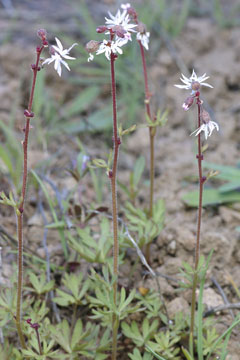 |
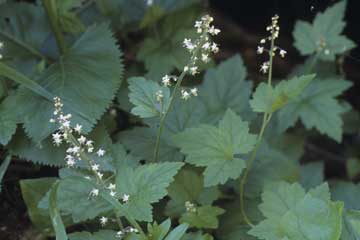 |
Threeleaf foamflower, Tiarella
trifoliata L. var. unifoliata
(Hook.) Kurtz (left; right) also known as the coolwort, and the laceflower)
prefers deep woods and well-shaded stream banks. Tiny, white, five-petaled
flowers are borne in small clusters (“panicles”) on stemlets arising
from a single long stem. The varietal name, unifoliata, differentiates
this variety from var. trifoliata (shown on the right) in which the
leaves are divided into three separate leaflets, rather than the single,
lobed leaves of the plant shown here.
|
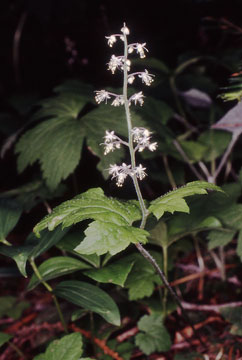 |
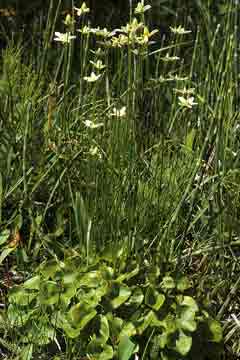 |
Grass-of-Parnassus family, Parnassiaceae
Fringed grass-of-Parnassus, Parnassia
fimbriata K. D. Koenig (right, left).
Parnassia species were, until recently, members of the saxifrage family.
Parnassia palustris L. (not shown), a circumboreal, subalpine and
alpine plant that grows throughout the northern hemisphere (including northern
Idaho, is the original grass-of-Parnasssus. The name was given by Dioscorides
who associated the plant with the Parnassus Range in Greece, where it grows
today. Our plant, Parnassia fimbriata ,is almost identical except
for its fringed (“fimbriated”) petals. It blooms from midsummer
on in swampy mountain meadows, and along the banks of slow moving streams,
at montane to alpine elevations. The plants have single white flowers atop
naked stems that emerge from basal clumps of kidney-shaped leaves. Five stamens
emerging from between the petals are tipped with club-like yellow anthers.
A yellow “staminode”—a modified, sterile, yellow nectar-secreting
stamen—is located at the base of each petal. |
 |



















